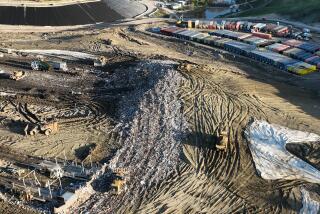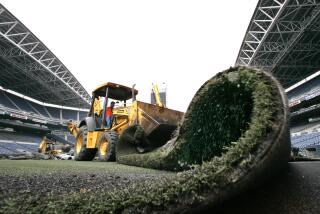Argument for More Dumps Is Garbage
I find it surprising that The Times would tout the obsolete technology of landfills in its May 19 editorial âLandfill Capacity: A Problem We Canât Just Sweep Away.â Los Angeles County has promoted a âtime to crisisâ--a time when we will have garbage in the streets--since 1989. They said it would happen if Sunshine Canyon didnât reopen in 1991. They said it would happen if something wasnât done by 1995. Now, in their recently released Waste Plan and Siting Element, they say it will happen by 1998 if new landfills donât come on line. They have cried âwolfâ for so long, without any real creative effort to solve the problem, that no one believes them anymore.
So what is the real problem? Dumps! That and the countyâs insistence on making them the primary method of handling our garbage. An aversion to dumps is not just a NIMBY desire not to reduce property values in oneâs neighborhood--although this is a valid reason to oppose a dump. Garbage dumps are a major source of methane air pollution, and they have been shown to leak volatile organic compounds into ground water.
As we try to solve this areaâs problems with unhealthy air, we ask productive industries to cut back while giving variances to landfills that are unproductive and major polluters. This is an error in long-term planning. And air pollution has many other costs as well: reduced worker productivity, health-care expenses, loss of quality of life, all of which cause people and businesses not to want to locate here.
Water pollution is a dump byproduct that we can ill-afford in arid Southern California. As projected demand for water increases throughout the state, ground water becomes an ever-more-vital resource. Several dumps in the San Gabriel Valley and elsewhere are already threatening ground water with pollution or generating cleanup costs to taxpayers in the hundreds of millions of dollars.
The costs of air and water pollution created by dumps must be factored into the real cost of this waste disposal method. Economists call this the âmarginalâ cost, and although it is difficult to calculate, it is a real long-term cost to society. It makes dumps substantially more expensive than what is charged at the gate.
In The Timesâ editorial, a waste generation rate of 50,129 tons per day is quoted. This may be the generation rate, but the actual disposal rate is 39,000 TPD, according to the countyâs recently released Waste Plan, down substantially from the last several years. Recycling is working.
Even The Times is somewhat skeptical of these county Department of Public Works projections: The editorial says âone could argue that the countyâs projections are wildly inflated.â In fact, many organizations are arguing just that. The county has based its population projections on data that do not accurately reflect the situation. These data have produced a projected increase in trash generation figures that is exaggerated.
The Department of Public Works also based its trash generation figures in part on state Department of Finance sales tax data. Since these figures are not broken down by county, a statewide average was used. This method produced inaccuracies for Los Angeles County because the rest of the state grew at a much faster rate over the past several years. In a March 8 article, The Times said that U.S. Census Bureau data showed very little growth in L.A. Countyâs population last year. Emigration was only barely balanced by an influx of lower-income immigrants (and these folks generate far less trash than the wasteful upper socioeconomic brackets). Actual growth is far less than the rate the county has chosen to use.
Beyond statistical arguments, Los Angeles city and county have available a number of proven waste disposal techniques that would extend the life of existing landfills. Among these is bailing, a compacting process. Also, we have a gross overcapacity--as much as a 100-year supply--of landfill space for inert materials. To conserve scarcer Class III space (that intended for nonhazardous household waste), we should divert all inert materials away from these facilities. And finally, as the city of Los Angeles phases in volume-based pricing, we should acknowledge that trash generation undoubtedly will decrease.
*
So we still have several years to make a legitimate effort to move away from this polluting method of waste disposal. It is time for the county to actively pursue new technologies rather than discourage them. It is time to put out requests for partnership proposals and to reach out to solutions used in other states, rather then flounder blindly in an old, polluting technology. Itâs time to listen to the public outcry against new dumps.
More to Read
Sign up for Essential California
The most important California stories and recommendations in your inbox every morning.
You may occasionally receive promotional content from the Los Angeles Times.










